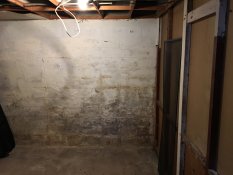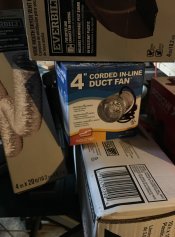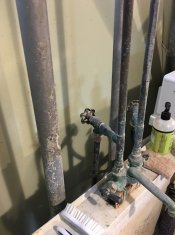RetroFuture
Member
Hi! I've been a long-time reader but first-time poster who's trying to make the leap to a budget darkroom space. I bought a bunch of darkroom equipment (enlargers, trays, lights, timers, etc.) very inexpensively so I'm good there. I identified a spot in my basement but I don't have a lot of experience building or framing. I was hoping I could maybe get some advice. the space is about 8-foot by 5-6 foot. I'll attach a picture of the space.

1. I was thinking I could just get some plastic sheeting, build a frame with 2x4's and deck screws and staple it to the frame, put a few tables in there (one for dry side, one for wet maybe with the trays sitting in a bigger tray of some kind) stick a 4inch dryer vent fan on one end and run a tube out the other. Is this a good idea? I thought I could just hang some sheeting or curtains but light gets in the top. I purchased some of the stuff to do this but then had second thoughts hence the post.
Here's what I bought: ... and here's the light leak I was talking about:
... and here's the light leak I was talking about:

2. If I do that do I run into issues with code, etc? I don't want to do anything I shouldn't.
3. Should I be more ambitious? I'm enthusiastic enough I'd spend one or two thousand dollars but don't have much more.
4. Across the sheet rock wall on the other side is the basement sink-- would it be really expensive to somehow connect to it? Worst case I'll just walk around to wash prints.
Here's the sink plumbing:
I've attached pictures of the space, some of the things I've bought and the laundry plumbing across the wall. Incidentally Photrio is amazing - I've received great advice over the years in how to develop and make the few prints I was able to try in our bathroom. For me having a darkroom would be amazing so I'm hoping I can make it work... I find analog work so much more satisfying I'd probably sell my digital setup to fund it if I need to.

1. I was thinking I could just get some plastic sheeting, build a frame with 2x4's and deck screws and staple it to the frame, put a few tables in there (one for dry side, one for wet maybe with the trays sitting in a bigger tray of some kind) stick a 4inch dryer vent fan on one end and run a tube out the other. Is this a good idea? I thought I could just hang some sheeting or curtains but light gets in the top. I purchased some of the stuff to do this but then had second thoughts hence the post.
Here's what I bought:
 ... and here's the light leak I was talking about:
... and here's the light leak I was talking about:

2. If I do that do I run into issues with code, etc? I don't want to do anything I shouldn't.
3. Should I be more ambitious? I'm enthusiastic enough I'd spend one or two thousand dollars but don't have much more.
4. Across the sheet rock wall on the other side is the basement sink-- would it be really expensive to somehow connect to it? Worst case I'll just walk around to wash prints.
Here's the sink plumbing:

I've attached pictures of the space, some of the things I've bought and the laundry plumbing across the wall. Incidentally Photrio is amazing - I've received great advice over the years in how to develop and make the few prints I was able to try in our bathroom. For me having a darkroom would be amazing so I'm hoping I can make it work... I find analog work so much more satisfying I'd probably sell my digital setup to fund it if I need to.
Last edited:












